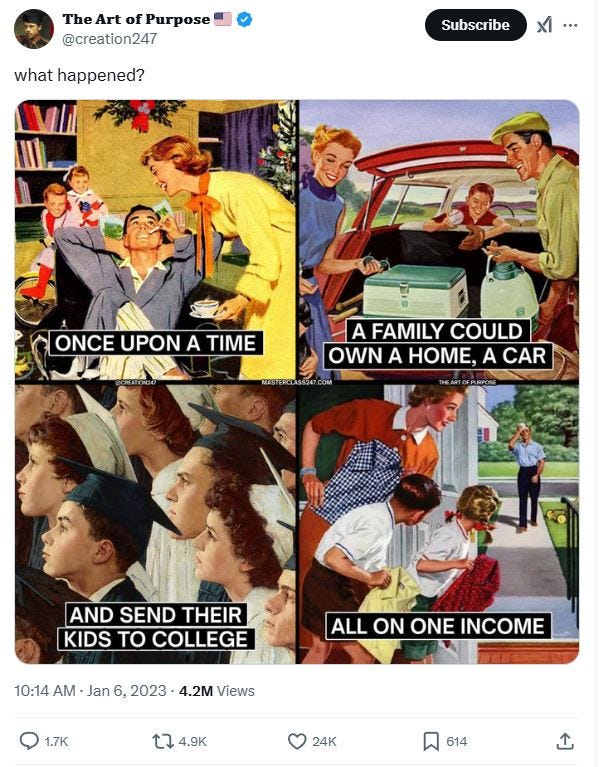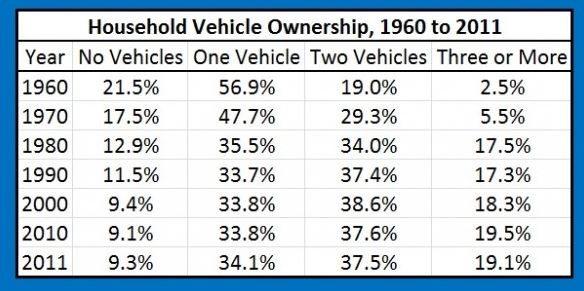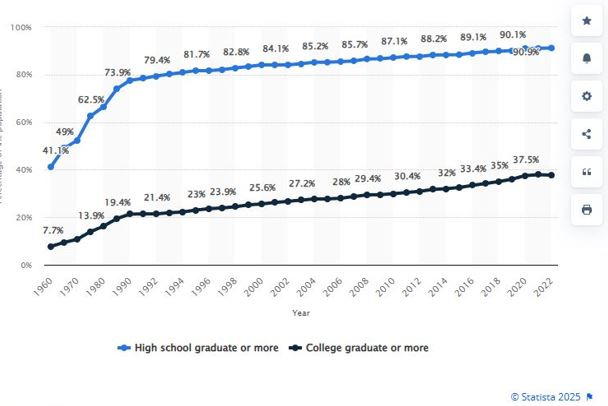No, Americans Didn’t Have It Economically Better in the ‘Good Old Days’
Not only do we human beings tend to idealize the past, but all of us have had to deal with the painful surge of inflation during the Biden administration. Not everyone fully understands how bad it was because the government plays a lot of games with the way they compile the overall inflation rate, but if you look at some of the key purchases people care the most about, it’s easy to understand why many people feel so grim about our economic situation.
For example, take home prices:
In past decades, it was common to find a house that cost roughly three times a buyer's annual income. But that ratio has skewed sharply since the COVID-19 pandemic, with home prices up a whopping 47% since early 2020. Median home sales prices last year were about five times the median household income, according to tabulations in a newly released report by the Harvard Joint Center for Housing Studies, and there are signs it could get worse.
Similarly, the cost of buying a car has surged as well:
Yes, prices have come down from their pandemic peaks, but if you haven’t walked into a dealership since early 2020, the prices you see will be “eye-popping,” said Pat Ryan, chief executive of CoPilot, an AI-assisted car-shopping app. New car prices are up 29% since March 2020 and used car prices up 34%, both outpacing overall inflation of 23%, he said.
We also can’t forget food. Let’s look at the staple food that has drawn the most complaints - Eggs:
In January of 2020, they were $1.46 per dozen and in November of 2024, they were up to $3.65 average. That’s a 150% cost increase in just four years. On top of all those admittedly painful cost of living increases, all of us know the stories about the “good old days,” when one guy doing a manual labor job was able to support a wife and three kids. If you believe the memes, they were practically living a life of luxury compared to us:
So, were past generations of Americans REALLY doing financially better than we are today? A lot of people think they were and certainly, someone making a meme wouldn’t suggest something untrue, would they? Sadly, yes. The memes aren’t true.
Why?
Well, to begin with, we can actually look at the per capita income Americans make in today’s dollars, and Americans today make MUCH MORE MONEY than people did back in the “good old days”:
There’s just no comparison between what we make today and what people made back then.
At first glance, that doesn’t seem to compute, but if you understand human nature, it makes perfect sense. You see, one of the most common financial mistakes people make is to let their lifestyle rise to meet their income.
In fact, when I was in Mexico City last year, I was told that was a big problem among Americans who moved there. You see, even though Mexico is somewhere between 40-50% cheaper (depending on where you live) than the United States, the Americans who moved there to save money were having a hard time. Why? Because they were getting a really nice house. A much nicer one than they could afford in the United States. Then they were special ordering things from the US they couldn’t get in Mexico. They also hired gardeners, maids, and cooks. Given how cheap it is to hire people in Mexico, why not, right? Except when they got done with all that, they were essentially spending the same amount they were in the States.
Yes, they had a better lifestyle, but they didn’t actually save any money moving to a place that may have cost half as much as where they lived before.
That’s why comparing what past generations of Americans had to what Americans today have is not an apples-to-apples comparison. Even if you ignore the fact that percentage-wise, significantly more Americans own homes today than in 1950…:
…the homes people owned back then were, for the most part, not comparable to the ones people own today. As a starter, they were much smaller:
The average home size in the U.S. was 983 square feet in 1950, 1,500 square feet in 1970, and 2,349 square feet in 2004. The median size of a newly built home in the second quarter of 2024 was 2,164 square feet.
They also weren’t as nice. For example, my grandmother’s house literally did not have a shower when it was built, and her cellar had a dirt floor.
Similarly, consider cars. It goes without saying that the cars we have today are orders of magnitude better than the cars they had back then, but percentage-wise, they’re also more widely owned today as well:
What about college though? The meme said they were sending their kids to college on one income. Well, once again, when you look at the actual numbers? Not so much:
On top of this, in the fifties, very few Americans had microwaves, dishwashers, or air conditioning. Back then, there were no computers, Playstations, Xbox, flat screen TVs, Uber, digital cameras, MP3 players, GPS, Amazon or cell phones. The point is we live a lifestyle that is orders of magnitude better than people did back then – and they did better than earlier generations of Americans. My dad grew up during the Depression and he told me stories about wearing shoes with holes in them, thinking soda and peanut butter were luxuries, and playing with a corncob that had feathers in it when he was a kid.
So, when people are like, “Why can’t we still support a family with 3 kids on one regular income like they used to be able to do back in the day?” Well, the reality is that you can if you’re willing to live like they did back then. Get a small house, 1 car, don’t go out to eat, and don’t grab Starbucks. Buy any “luxuries” and appliances in your house at yard sales, patch your clothes, etc., etc. If you have a bare-bones lifestyle, that single salary will stretch a lot further than you think.
However, the reality is that very few people outside of the Amish are willing to live like that. Of course, that’s understandable. I’ve used an outhouse before. I can’t say that I’d recommend it over indoor plumbing. I’m also sure my grandmother would have much rather bought her dinner at the store rather than feeding chickens, taking their eggs, and then wringing their neck one day so they’d have something for dinner.
What it all comes down to is that ultimately, it’s your choice. Know the facts and make it with your eyes wide open.










Excellent reminder that our faulty memories often fail to give us realistic expectations.